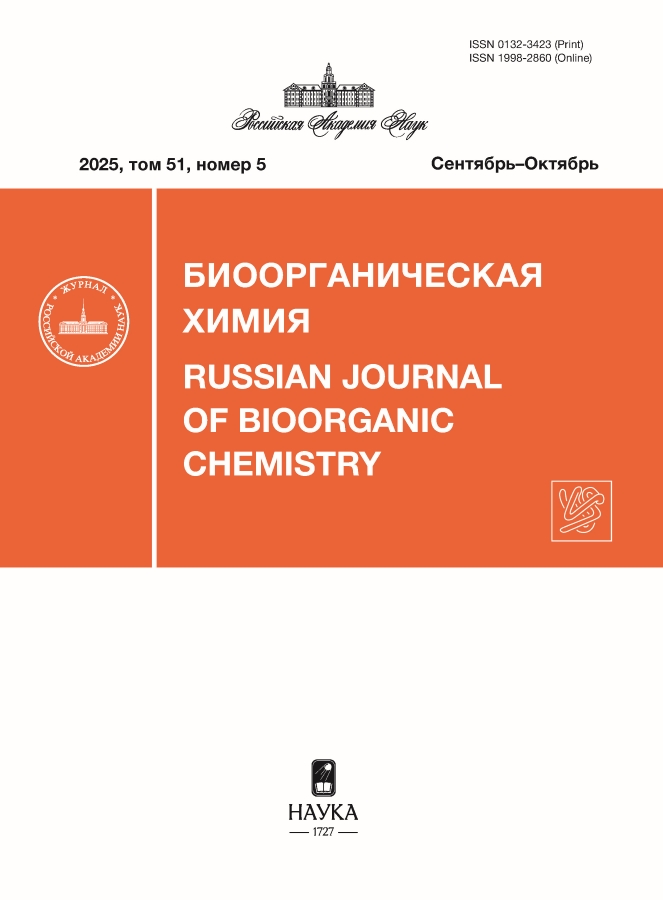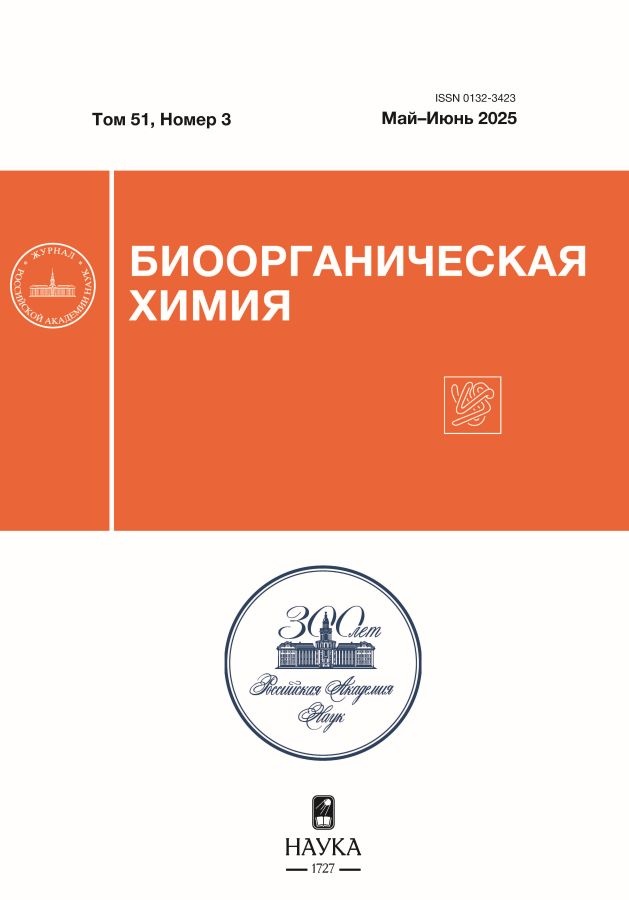Регуляция стабильности транскриптов гена плюрипотентности семейства pou5f3 рибонуклеопротеиновыми комплексами Ybx1 на ранних этапах развития Xenopus laevis
- Авторы: Паршина Е.А.1, Зарайский А.Г.1, Мартынова Н.Ю.1
-
Учреждения:
- ФГБУН ГНЦ “Институт биоорганической химии им. академиков М.М. Шемякина и Ю.А. Овчинникова” РАН
- Выпуск: Том 51, № 3 (2025)
- Страницы: 486-495
- Раздел: ОБЗОРНАЯ СТАТЬЯ
- URL: https://vietnamjournal.ru/0132-3423/article/view/686997
- DOI: https://doi.org/10.31857/S0132342325030113
- EDN: https://elibrary.ru/KRCMXF
- ID: 686997
Цитировать
Полный текст
Аннотация
Проведено исследование механизма регуляции стабильности транскриптов генов семейства pou5f3 белком рибонуклеопротеиновых комплексов Ybx1. Известно, что у шпорцевой лягушки Xenopus laevis есть три гена семейства POU5: pou5f3.1/oct91, pou5f3.2/oct25, pou5f3.3/oct60. Факторы семейства Pou5f.3 выступают ортологами фактора плюрипотентности эмбриональных стволовых клеток OCT4 млекопитающих. При этом экспрессия генов, кодирующих эти факторы, различается во времени. Так, транскрипты гена pou5f3.3/oct60 запасаются в ооцитах, присутствуют в большом количестве в оплодотворенной яйцеклетке – зиготе, а далее только деградируют. Транскрипты pou5f3.2/oct25 также присутствуют зиготе, но в дальнейшем развитии их количество еще более возрастает. Наконец, транскрипция pou5f3.1/oct91 начинается только после активации генома зародыша на стадии средней бластулы. Нами выявлена гораздо более высокая специфичность фактора Ybx1 к образованию комплекса с материнской мРНК гена pou5f3.3/oct60 по сравнению с зиготическими мРНК генов pou5f3.1/oct91, pou5f3.2/oct25. Поскольку Ybx1 – белок, который с одной стороны, участвует во взаимодействии с белками цитоскелета, а с другой, связывает и стабилизирует материнскую мРНК генов плюрипотентности, можно предположить его связующую роль между деградацией этих материнских транскриптов и перестройкой цитоскелета в период начала морфогенетических движений клеток в процессе формирования зародышевых листков.
Ключевые слова
Полный текст
Об авторах
Е. А. Паршина
ФГБУН ГНЦ “Институт биоорганической химии им. академиков М.М. Шемякина и Ю.А. Овчинникова” РАН
Email: martnat61@gmail.com
Россия, 117997 Москва, улица Миклухо-Маклая, 16/10
А. Г. Зарайский
ФГБУН ГНЦ “Институт биоорганической химии им. академиков М.М. Шемякина и Ю.А. Овчинникова” РАН
Email: martnat61@gmail.com
Россия, 117997 Москва, улица Миклухо-Маклая, 16/10
Н. Ю. Мартынова
ФГБУН ГНЦ “Институт биоорганической химии им. академиков М.М. Шемякина и Ю.А. Овчинникова” РАН
Автор, ответственный за переписку.
Email: martnat61@gmail.com
Россия, 117997 Москва, улица Миклухо-Маклая, 16/10
Список литературы
- Onichtchouk D. // Biochimica et Biophysica Acta. 2016. V. 1859. P. 770–779. https://doi.org/10.1016/j.bbagrm.2016.03.013
- Gold D.A., Gates R.D., Jacobs D.K. // Mol. Biol. Evol. 2014. V. 31. P. 3136–3147. https://doi.org/10.1093/molbev/msu243
- Rosner M.H., Vigano M.A., Ozato K., Timmons P.M., Poirier F., Rigby P.W., Staudt L.M. // Nature. 1990. V. 345. P. 686-692. https://doi.org/10.1038/345686a0
- Downs K.M. // Dev Dyn. 2008. V. 237. P. 464–475. https://doi.org/10.1002/dvdy.21438
- Morichika K., Sugimoto M., Yasuda K., Kinoshita T. // Zygote. 2014. V. 22. P. 266-274. https://doi.org/10.1017/S0967199412000536
- Hinkley C.S., Martin J.F., Leibham D., Perry M. // Mol. Cell. Biol. 1992. V. 12. P.638–649. https://doi.org/10.1128/mcb.12.2.638-649.1992
- Cao Y., Knochel S., Donow C., Miethe J., Kaufmann E., Knochel W. // J. Biol. Chem. 2004. V. 279. P. 43735– 43743. https://doi.org/10.1074/jbc.M407544200
- Cao Y., Siegel D., Knöchel W. // Mech Dev. 2006. V. 123. P. 614–625. https://doi.org/10.1016/j.mod.2006.06.004
- Cao Y., Siegel D., Donow C., Knöchel S., Yuan L., Knöchel W. // EMBO J. 2007. V. 26. P. 2942–2954. https://doi.org/10.1038/sj.emboj.7601736
- Parshina E.A., Zaraisky A.G., Martynova N.Yu. // Bioorg. Chem. 2020. V. 46. P. 1–10. https://doi.org/10.2139/ssrn.3554017
- Jacobson A., Peltz,S.W. // Ann. Rev. Biochem. 1996. V. 65. P. 693–739. https://doi.org/10.1146/annurev.bi.65.070196.003401
- Evdokimova V.M., Ovchinnikov L.P. // Int. J. Biochem. Cell. Biol. 1999. V. 31. P. 139–149. https://doi.org/10.1016/s1357-2725(98)00137-x
- Evdokimova V., Ruzanov P., Imataka H., Raught B., Svitkin Y., Ovchinnikov L.P., Sonenberg N. // EMBO J. 2001. V. 20. P. 5491–5502. https://doi.org/10.1093/emboj/20.19.5491
- Bouvet P., Matsumoto K., Wolffe A.P. // J. Biol. Chem. 1995. V. 270. P. 28297–28303. https://doi.org/10.1074/jbc.270.47.28297
- Eliseeva I.A., Kim E.R., Guryanov S.G., Ovchinnikov L.P., Lyabin D.N. // Biochemistry (Moscow). 2011. V. 76. P. 1402–1433. https://doi.org/10.1134/S0006297911130049.
- Parshina E.A., Eroshkin F.M., Оrlov E.E., Gyoeva F.K., Shokhina A.G., Staroverov D.B., Belousov V.V., Zhigalova N.A., Prokhortchouk E.B., Zaraisky A.G., Martynova N.Y. // Cell. Rep. 2020. V. 33. P. 108396. https://doi.org/10.1016/j.celrep.2020.108396
- Martynova N.Y., Parshina E.A., Zaraisky A.G. // STAR Protocols. 2021. V. 2. P. 100552. https://doi.org/10.1016/j.xpro.2021.100552
- Livigni А., Peradziryi H., Sharov A.A., Chia G., Hammachi F., Portero Migueles R.P., Sukparangsi W., Pernagallo S., Bradley M., Nichols J., Ko M.S.H., Brickman J.M. // Curr. Biol. 2013. V. 23 P. 2233– 2244. https://doi.org/10.1016/j.cub.2013.09.048
- Ruzanov P.V., Evdokimova V.M., Korneeva N.L., Hershey J.W., Ovchinnikov L.P. // J Cell Sci. 1999. V. 112. P. 3487–3496. https://doi.org/10.1242/jcs.112.20.3487
- Martynova N.Y., Parshina E.A., Eroshkin F.M., Zaraisky A.G. // Russ. J. Bioorg. Chem. 2020. V. 46. P. 530–536. https://doi.org/10.1134/S1068162020040147
- Livak K.J., Schmittgen T.D. // Methods. 2001. V. 25. P. 402–408. https://doi.org/10.1006/meth.2001.1262
- Ivanova A.S., Korotkova D.D., Martynova N.Y., Averyanova O.V., Zaraisky A.G., Tereshina M.B. // Russ. J. Bioorg. Chem. 2018. V. 44. P. 358–361. https://doi.org/10.1134/S106816201803007X
Дополнительные файлы













